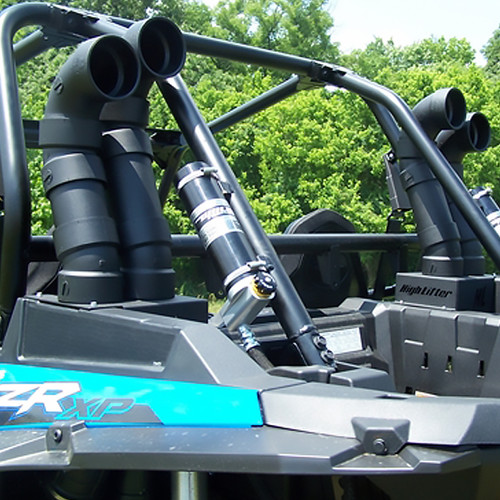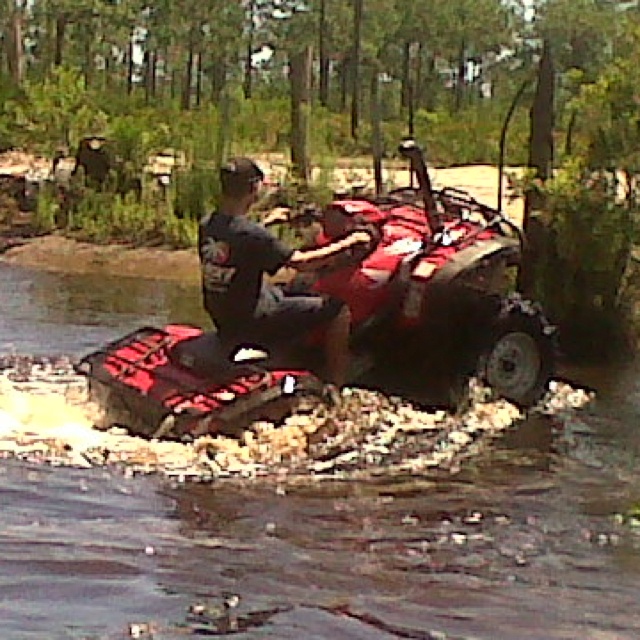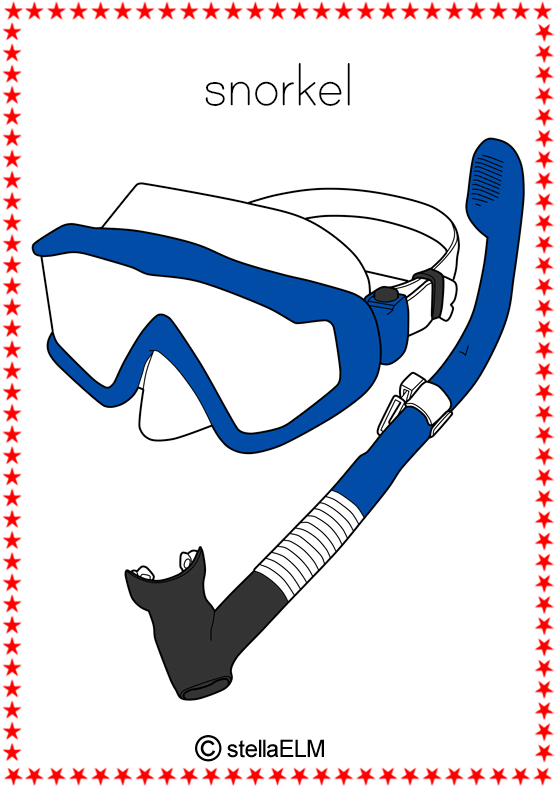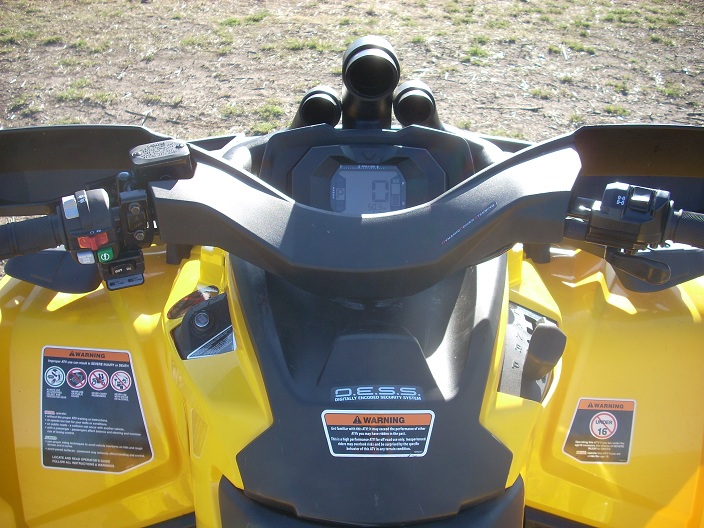A snorkel kit can give you safe access to terrain that is currently unwise to tackle. But is the benefit worth it? And how do you install a snorkel kit on your ATV?
An ATV snorkel kit protects your engine from the dangers of water and mud by keeping the water away from the engine and feeding air in, so your ATV can keep working regardless of where you take it.
The most basic aspect of a snorkel system is to shield the engine and run the snorkel from the engine's air intake system up high to a new location away from any water or mud you may drive in. This is the most crucial part of your machine to be protected, but because there are many other components that need to stay dry or to get air, snorkel kits often cover other vehicle parts as well. This will vary from kit to kit.
Installing a snorkel kit may sound like a no-brainer. Why wouldn't you want one? But there are some downsides to consider before you make a purchase.
You can more safely tackle mud and watery areas. Many places you need to avoid now because they'll be too deep for your machine will be available to you.
ATV are the core piece of riding gear for off-road riders
Find out the best look for you
You could get a false sense of security and still damage your machine. Snorkels can't provide 100% protection against water damage, they just greatly reduce it. So, you wouldn't want to act like your ATV is a submarine.
It is illegal to ride on public land with a snorkel kit in certain states. You should be able to ride on private land anywhere, but before you add a snorkel, you'll need to determine if it will impact where you can ride.
You will need to add the snorkel system to your routine maintenance list to make sure it doesn't get cracks, start leaking, or develop some other surprise issue.
You'll have to cut holes in your body work to run the snorkel through.
If you don't install the snorkel system exactly right, you could seriously damage your ATV. Make sure you are 100% confident you can do the install or that you hire a pro to do it for you.
Snorkel kits need to be designed for your exact ATV model.
There are kits that come only with air intake snorkels and the parts you'll need to install those.
You can also find kits that include some combination of snorkels for transmission vents, belt drive areas, drive train differentials, exhaust, and more.
Snorkel kits also come in ram or cyclone/vortex styles. The ram style forces air into the car as you ride. Any dirt and debris in that air is forced to the back of the snorkel where it escapes through holes or a dump valve. The cyclone style is made with a bowl-shaped head. The air swirls inside and dirt and debris collect in the sides of the bowl where they are farther away from the air filter.
Cyclone styles are better for your air filter but not as good for your power and fuel economy. So you'll have to decide whether the air filter, your power, or your fuel economy get top priority.
If you intend to drive your ATV in deep water or mud, you should seriously consider snorkeling your ATV. Make sure you install it correctly and that it is legal to ride a snorkeled ATV where you want to ride.
You should also make sure that snorkeling your particular machine will benefit you. The ATV should have a rated wading depth, telling you the machine has been proven to be relatively safe against water at that depth. If your machine has no rated wading depth, your machine may have no built-in protection against water and a snorkel can't provide as much protection as you need.
Make sure to buy a kit that is designed for your specific ATV.
Partially assembled kits are easier to install. You might want to look for one of those.
If you do plenty of riding outside of the mud where tipping and rollovers might be more likely, you may need to purchase a snorkel kit with a crash plate to offer the benefit of protecting your vehicle should the snorkel be ripped off in an accident.
Invest in at least a moderately-priced snorkel kit from a trusted brand. This is too important to rely on cheap, unreliable parts.
The kit should include all the parts you need and detailed instructions. Be sure before you begin.
You'll probably need to remove both of the side panels on your machine. This may require the removal of other parts, depending on your machine.
Spray the engine and the air intake area with degreaser.
Pressure wash the engine, clutch covers, and intake area.
Dry the area completely with compressed air.
You may need to remove and clean other components depending on your machine and the kit.
You will need to drill holes for the snorkel. The exact location will depend on the snorkel and your machine.
There will be couplers you need to install.
These steps will probably need to be repeated for more parts, depending on your kit.
Give your snorkels extra support by zip-tying them.
Replace the parts of your machine that you removed.
You will need to give your ATV a test ride and make sure it isn't running lean because you've increased the air flow. If so, you can install a reducer on the appropriate snorkel or reset to compensate for increased airflow.
SPORTSMAN
36 EUR
ENDURO
the most durable
577 EUR
AQUAMASTER-ZIP LIGHT
with central zipper
568 EUR
ENDURO LIGHT
the most durable
378 EUR
AQUAMASTER LIGHT
reliability & comfort
438 EUR
NEODRY
16 EUR
ENDURO
the most durable
229 EUR
AQUAMASTER
reliability & comfort
567 EUR
-30%
HIT
AQUAMASTER
reliability & comfort
259 EUR
181. 30 EUR
30 EUR
BELT
8 EUR
ENDURO BF
bootfoot waders
468 EUR
ENDURO BF
bootfoot waders
289 EUR
ENDURO
29 EUR
NEOSENSOR
14 EUR
9.80 EUR
MUDWAY
179 EUR
TARGET 20L
32 EUR
22.40 EUR
MUDRIDER
299 EUR
209.30 EUR
WADEMAN
lightweight waders
159 EUR
MUDWAY NEW
199 EUR
URBAN
79 EUR
Explore all
Select a country
Afghanistan
Albania
Algeria
Andorra
Angola
Anguilla
Antarctica
Antigua and Barbuda
Argentina
Armenia
Aruba
Australia
Austria
Azerbaijan
show more
Bahamas
Bahrain
Bangladesh
Barbados
Belarus
Belgium
Belize
Benin
Bermuda
Bhutan
Bolivia
Bosnia and Herzegowina
Botswana
Bouvet Island
Brazil
British Indian Ocean Territory
British Virgin Islands
Brunei Darussalam
Bulgaria
Burkina Faso
Burundi
show more
Cambodia
Cameroon
Canada
Cape Verde
Cayman Islands
Central African Republic
Chad
Chile
China
Christmas Island
Cocos Islands
Colombia
Comoros
Congo
Cook Islands
Costa Rica
Cote D'ivoire
Croatia
Cuba
Cyprus
Czechia
show more
Denmark
Djibouti
Dominica
Dominican Republic
East Timor
Ecuador
Egypt
El Salvador
Equatorial Guinea
Eritrea
Estonia
Ethiopia
show more
Faeroe Islands
Falkland Islands
Fiji
Finland
France
French Antarctic
French Guiana
French Polynesia
show more
Gabon
Gambia
Georgia
Germany
Ghana
Gibraltar
Greece
Greenland
Grenada
Guadeloupe
Guatemala
Guinea
Guinea-bissau
Guyana
show more
Haiti
Heard and McDonald Islands
Honduras
Hong Kong
Hungary
Iceland
India
Indonesia
Iran
Iraq
Ireland
Israel
Italy
show more
Jamaica
Japan
Jordan
Kazakhstan
Kenya
Kiribati
Korea (North)
Korea (South)
Kuwait
Kyrgyzstan
show more
Laos
Latvia
Lebanon
Lesotho
Liberia
Libya
Liechtenstein
Lithuania
Luxembourg
show more
Macau
Macedonia
Madagascar
Malawi
Malaysia
Maldives
Mali
Malta
Marshall Islands
Martinique
Mauritania
Mauritius
Mayotte
Mexico
Micronesia
Moldova
Monaco
Mongolia
Montenegro
Montserrat
Morocco
Mozambique
Myanmar
show more
Namibia
Nauru
Nepal
Netherlands
Netherlands Antilles
New Caledonia
New Zealand
Nicaragua
Niger
Nigeria
Niue
Norfolk Island
Norway
show more
Pakistan
Palau
Palestine
Panama
Papua New Guinea
Paraguay
Peru
Philippines
Pitcairn Islands
Poland
Portugal
Puerto Rico
show more
Reunion
Romania
Russia
Rwanda
Saint Helena
Saint Kitts and Nevis
Saint Lucia
Saint Vincent and the Grenadines
Saint-Pierre and Miquelon
Samoa
San Marino
Saudi Arabia
Senegal
Serbia
Seychelles
Sierra Leone
Singapore
Slovakia
Slovenia
Solomon Islands
Somalia
South African Republic
South Georgia and the South Sandwich Islands
Spain
Sri Lanka
Sudan
Suriname
Svalbard and Jan Mayen Islands
Swaziland
Sweden
Switzerland
Syria
show more
Taiwan
Tajikistan
Tanzania
Thailand
Togo
Tokelau
Tonga
Trinidad and Tobago
Tunisia
Turkey
Turkmenistan
Turks Caicos Islands
Tuvalu
show more
U. S. Virgin Islands
S. Virgin Islands
United States
Uganda
Ukraine
United Arab Emirates
United Kingdom
Uruguay
Uzbekistan
show more
Vanuatu
Vatican City
Venezuela
Viet Nam
Wallis and Futuna Islands
Western Sahara
Zaire
Zambia
Zimbabwe
{{#DETAIL_PAGE_URL}} {{SECTION_NAME}} {{NAME}} {{/DETAIL_PAGE_URL}}
Color: {{COLOR}}
{{#IS_SIZE}} Size: {{SIZE}} {{/IS_SIZE}}
Quantity:
Only {{AVAILABLE_QUANTITY}} left
{{#SHOW_DISCOUNT_PRICE}}
{{{SUM_FULL_PRICE_FORMATED}}}
{{/SHOW_DISCOUNT_PRICE}}
{{{SUM_PRICE_FORMATED}}}
{{/GIFT}} {{#GIFT}}
{{/GIFT}} {{/EMPTY_BASKET}} {{#EMPTY_BASKET}}
Your basket is empty
{{/EMPTY_BASKET}}
{{/FREE_SHIPPING}} {{#FREE_SHIPPING}}Free shipping available
{{/FREE_SHIPPING}}{{^FREE_SHIPPING}}
{{{FREE_SHIPPING_PERCENT}}}%
{{/FREE_SHIPPING}}
{{{FREE_SHIPPING_PRICE}}}
CHECKOUT {{{PRICE_FORMATED}}}
{{/EMPTY_BASKET}} {{#EMPTY_BASKET}} {{/EMPTY_BASKET}}Continue shopping
Your cart:
Your basket is empty
Skip to content
ATV
OT 906 , 00 €
1 hour for ATV
OT 145 9000, 00 00 00 00 € ,0003,0003,000 20006 ATV
TICKETS AVAILABLE
Season - All year round
Total time approx. 1.5 - 2.5 hours
1.5 - 2.5 hours
Starting 08:30:30 - 18:00
Difficulty - Beginner
Driving Issue B -1
Age - from 6 years
Available by car
Payment Payment
INFORMATION
FREQUENTLY ASKED QUESTIONS
ATV (ATV) is a small SUV for one or two people with four thick wheels. The name comes from the Latin quadri (four). In English-speaking countries, the term ATV (all-terrain vehicle) is mostly used. As a special car, we must know the characteristics of what we are going to drive and know its driving behavior.
We will study the situations that we may encounter during the tour and see how to deal with different situations in order to operate safely and enjoy the benefits that our Quad offers us.
Driving an ATV isn't difficult or easy, it's just a different vehicle than the one we normally drive every day. That's why it's important to understand Quad in order to use it fully and with absolute safety.
Avoid unnecessary risks
The purpose of this driving is to study and get to know the vehicle we are going to drive, and at the same time we discover its advantages and enjoy nature and its scenery, always respecting any person whom we can meet during the tour and our flora and fauna.
Can I race with my ATV?
The competitor must clearly understand that he is not taking part in the competition, but that what we will be doing will be a sports / tourism event. This means that we will start the exercise in such a way that the participant learns and adapts to driving an ATV. The monitor will indicate the driving method and rhythm that best suits their level, as well as give some guidance during the session to instruct the participant and at the same time correct any indiscretion they may commit. voluntarily or involuntarily. Depending on how the participants develop, we will raise the level.
voluntarily or involuntarily. Depending on how the participants develop, we will raise the level.
These are quiet excursions where safety is important and all clients are expected to be satisfied.
What happens if I don't follow the instructions in the manual?
Quad is a special car and its main characteristic is that it does not require speed to get the most out of driving, so: COMPETITIVE.
Which route are we going to take?
Our excursions are very complete: we will move on asphalt, passing through villages and wide forest paths with ups and downs, roads with slopes, river fords, etc.
How big are the ATVs?
ATVs - 300cc. The difficulty of the routes will be adapted to the level of participants.
Do I need prior knowledge?
No, ATVs are automatic and easy to handle without much technical knowledge. You only need to have a valid B1 driver's license.
You only need to have a valid B1 driver's license.
How big are the groups usually?
From 6-8 participants per guide.
Do you have food and drink in the hotel?
No, but you can buy non-alcoholic drinks and snacks at our camp.
Do TICKETS and vouchers expire if a booking is cancelled?
No, tickets and vouchers are still valid. If the appointment is cancelled, an alternative date will be assigned.
Published by: motocafe.ru from
Get on an ATV - and into the forest, into the mountains ... Yes, anywhere - as long as it is away from civilization! But off-road, even a super-reliable utilitarian device can easily “stagger”. Unless, of course, you do not prepare him for a meeting with wildlife.
Without protection of the bottom of the frame and suspension arms on quadrics, you can’t frolic in forests and swamps, and don’t even dare to think about participating in sports rides, and even more so trophy raids. We came up with a protection with which ATV is not afraid of stumps, snags or stones. Even "snorkeling" they do not care!
Manufacturers do not install protection on "utilitarians" - only on cross-country devices. But in them, she covers only her legs - if the machine rolls over. In this case, strong enough arcs. For forest rides, this design is not suitable. Firstly, the arcs are bolted under the frame, and they shorten the clearance by a centimeter or two. Off-road, every millimeter of ground clearance counts. Secondly, any stick will crawl through the grid of cross protection - and it will damage either the brakes, or the motor, or the transmission ... Anything! One of our acquaintances was sure that his Yamaha Grizzly was already equipped with everything he needed. But he was disappointed - after the second repair of the "pierced" engine. The first time a sharp stick just pierced the cooling system hose, but all the antifreeze leaked out and the engine overheated. In another episode, the stick "reached out" to the thermostat and crushed its body.
But he was disappointed - after the second repair of the "pierced" engine. The first time a sharp stick just pierced the cooling system hose, but all the antifreeze leaked out and the engine overheated. In another episode, the stick "reached out" to the thermostat and crushed its body.
Protective sheets of our design cover the engine, suspension and brake parts. We developed it for traveling along the Khibiny rocks. She is not afraid even of meetings with large stones. It would seem that nothing special is like flimsy, at first glance, duralumin sheets. But they have one trick - they are with flanging, which enhances their rigidity.
When the guard slides over an obstacle, the hardest hit is the fasteners. Even if the stone does not “lick off” its head when it collides with the bolt, after several such “gentle” meetings it inevitably flattens out, and no tool other than a chisel can cope with the bolt. But you have to remove the protection sheets at each regular maintenance. And that's what we did. All the heads of the fixing bolts were sunk in special stampings. In cases where it is not possible to hide the bolt, we install fasteners with semicircular heads, they have internal hexagons (you must unscrew the bolts somehow!). In addition, the recesses for fasteners, imagine, also add rigidity to the duralumin sheet.
And that's what we did. All the heads of the fixing bolts were sunk in special stampings. In cases where it is not possible to hide the bolt, we install fasteners with semicircular heads, they have internal hexagons (you must unscrew the bolts somehow!). In addition, the recesses for fasteners, imagine, also add rigidity to the duralumin sheet.
Polaris has a different frame design than other ATVs. At first glance, this ATV's engine is more secure, and the flat bottom of the frame allows the machine to slide over stumps and logs. However, Polaris is not completely protected from trouble: through the cracks, the branches still reach the motor and can cause trouble. For these devices, “belly” tuning protection kits are sold, and you can install them yourself. But they are able to save only on the tracks of amateur rides, and for a more or less hard produbas they are rather weak. Heavy quads require stronger protection and, again, recessed fasteners.
When you “light up”, without choosing a path, you meet swamps, rivers and other water bodies. It is impossible to cross them without a snorkel (in other words, an air intake), but with it the device can move underwater like a submarine at periscope depth. So that the pipe does not interfere in the “surface” position, it can be folded, and in front of a water barrier it can be brought into working position in a matter of seconds ... For quads equipped with a variator, one snorkel is not enough. For example, Grizzly needs as many as three pipes. One, as usual, is for the engine, the other two are for the air cooling the variator. This is how the “three-pipe steamer” turns out.
It is impossible to cross them without a snorkel (in other words, an air intake), but with it the device can move underwater like a submarine at periscope depth. So that the pipe does not interfere in the “surface” position, it can be folded, and in front of a water barrier it can be brought into working position in a matter of seconds ... For quads equipped with a variator, one snorkel is not enough. For example, Grizzly needs as many as three pipes. One, as usual, is for the engine, the other two are for the air cooling the variator. This is how the “three-pipe steamer” turns out.
About wheels. To increase ground clearance, many install tires with larger diameters. But you can’t overdo it: with heavy wheels, an ATV is more difficult to control, it accelerates and slows down worse. This is especially felt when maneuvering at high speed. If the “five hundred” easily go on wheels with an outer tire diameter of 27 or even 28 inches, then something lighter is required on the “four hundred”. For them, just right 26-inch wheels. However, this is advice for those whose ATVs move on heavy steel rims. If you can afford expensive, but lightweight 14-inch aluminum alloy wheels, then the size of the wheels for the “four hundred” can be 28 inches. However, take into account that the larger the diameter of the rubber, the less traction on the wheels.
For them, just right 26-inch wheels. However, this is advice for those whose ATVs move on heavy steel rims. If you can afford expensive, but lightweight 14-inch aluminum alloy wheels, then the size of the wheels for the “four hundred” can be 28 inches. However, take into account that the larger the diameter of the rubber, the less traction on the wheels.
All this is what determines, without which it is pointless to meddle in the "pampas". But there are other means of improving SUVs. For example, bumpers that can protect plastic and lighting equipment from battle if you encounter an obstacle (in some ATV models they are simply not standard). They are also handy to grab onto when you have to pull the quad out of the quagmire...
All ATVs have different shapes of frames and suspension arms. This means that everyone needs special protection (from left to right): Polaris Magnum 330; Honda TRX400; Can-Am Outlander Max XT800 H.O.
If you like to travel alone, then be sure to attach an electric winch - without it, roaming through the forest is simply dangerous. Some even install two: front and rear. Well, the GPS-navigation device will save you from a lot of unnecessary thrills - and lead you on the right path ... You can also work with the engine, but this is more necessary for sports racing. Here Honda motors do not need to be finalized - their power is enough for the eyes. And the popular “grizlik” has rather weak rear-wheel drive hinges: under excessive loads, the “grenades” wear out quickly, the reliability margin of the drive shaft splines that enter the gearbox is depleted quite quickly: it happens that they pop out of the gearbox. We equipped our device with a kit that connects two hinges inside the gearbox and does not allow them to spontaneously leave their place. This design is much more durable.
Some even install two: front and rear. Well, the GPS-navigation device will save you from a lot of unnecessary thrills - and lead you on the right path ... You can also work with the engine, but this is more necessary for sports racing. Here Honda motors do not need to be finalized - their power is enough for the eyes. And the popular “grizlik” has rather weak rear-wheel drive hinges: under excessive loads, the “grenades” wear out quickly, the reliability margin of the drive shaft splines that enter the gearbox is depleted quite quickly: it happens that they pop out of the gearbox. We equipped our device with a kit that connects two hinges inside the gearbox and does not allow them to spontaneously leave their place. This design is much more durable.
And now about which four-wheeler to choose for extreme driving. Rear-wheel drive is better adapted for driving in a sporty style, for cross-country, for example. Here they benefit from their lighter weight. It is pointless to go to trophy raids without all-wheel drive. Yes, additional gearboxes increase the weight of the ATV, but you have to put up with it. Do not choose excessively heavy devices in pursuit of reliability; keep in mind, sometimes the quadric has to be taken out of the mud literally by hand. And not always what is big is durable. For example, Can-Am frames, for all their massiveness, are not rigid. Often on these quads with only 50-100 km mileage, you will find cracks on the paint of all brackets that are welded to the frame - a sure sign that the frame has insufficient torsional rigidity. At the Yamaha Grizzly, the condition of the CV joints has to be checked after each “hard” ride. With non-extreme operation, they rarely cause trouble, but in harsh conditions these parts are enough for 500-600 km - no more. And for all ATVs, you need to constantly monitor the condition of the CV joint anthers. Even through a small crack in the rubber band, dust will instantly fill the knot - and it will lose its performance in a matter of kilometers.
Yes, additional gearboxes increase the weight of the ATV, but you have to put up with it. Do not choose excessively heavy devices in pursuit of reliability; keep in mind, sometimes the quadric has to be taken out of the mud literally by hand. And not always what is big is durable. For example, Can-Am frames, for all their massiveness, are not rigid. Often on these quads with only 50-100 km mileage, you will find cracks on the paint of all brackets that are welded to the frame - a sure sign that the frame has insufficient torsional rigidity. At the Yamaha Grizzly, the condition of the CV joints has to be checked after each “hard” ride. With non-extreme operation, they rarely cause trouble, but in harsh conditions these parts are enough for 500-600 km - no more. And for all ATVs, you need to constantly monitor the condition of the CV joint anthers. Even through a small crack in the rubber band, dust will instantly fill the knot - and it will lose its performance in a matter of kilometers.